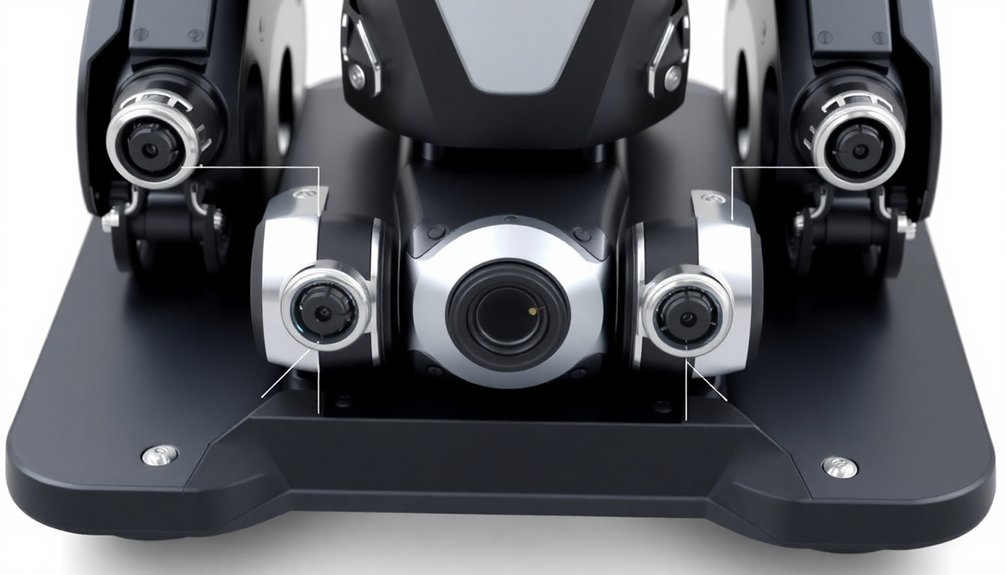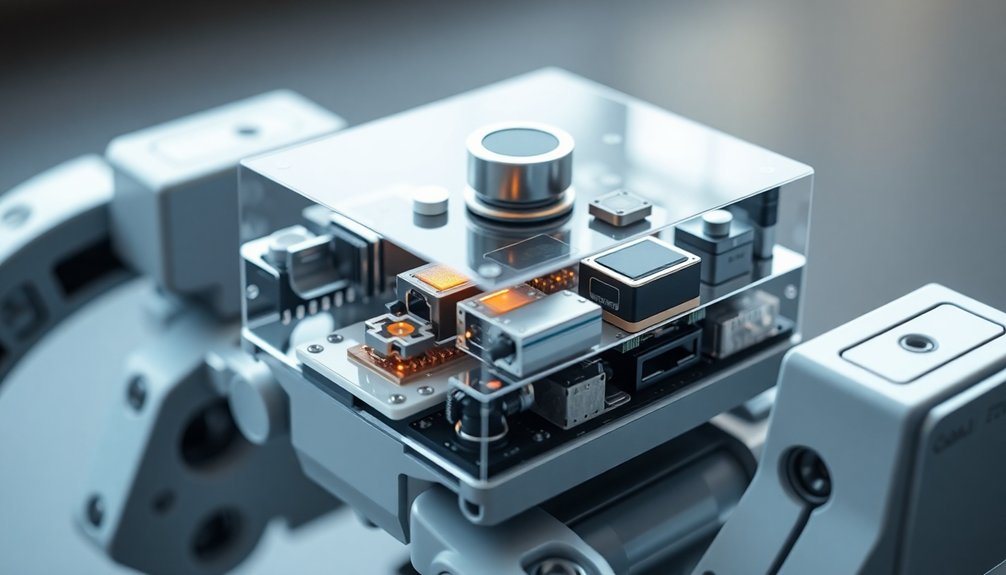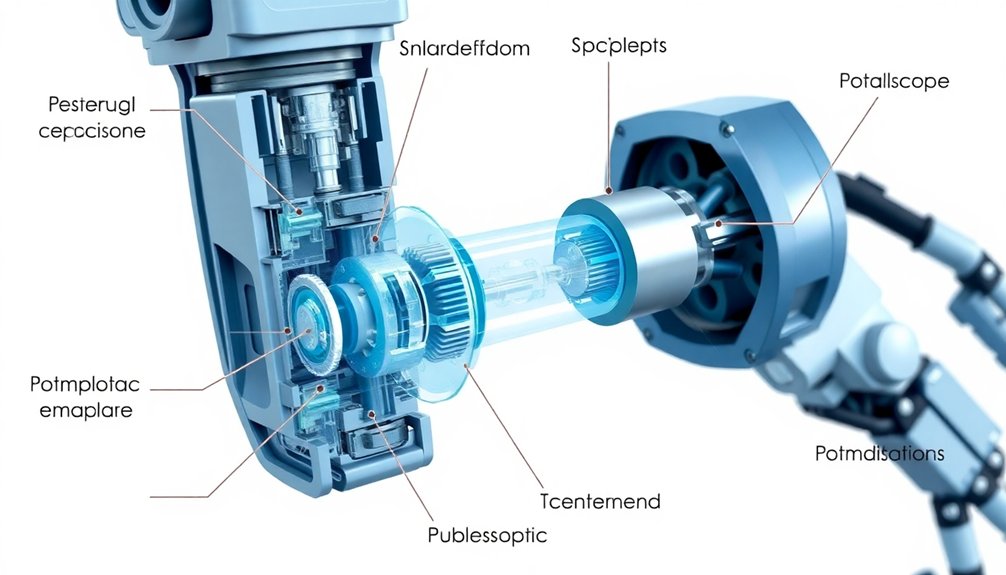Table of Contents
If you want a robot that doesn’t crash into walls or stare blankly like a confused toddler, you’ll need some killer sensors. GPS and LiDAR help it navigate, while cameras and ultrasonic sensors spot obstacles faster than you can say “oops.” Gyroscopes track movement, and proximity sensors prevent embarrassing collisions. Microphones let your robot eavesdrop—I mean, understand its environment. Want the full robotic upgrade? Stick around.
Essential Navigation and Movement Sensors

When robots roam the world, they’re basically blind wanderers without the right sensors—and that’s where navigation technology becomes their digital eyes and brain. Machine learning algorithms continuously enhance these navigation capabilities, allowing robots to adapt and improve their spatial understanding in real-time.
You’d be shocked how much tech goes into making these mechanical marvels move intelligently. GPS and RTK-GPS systems help robots pinpoint their outdoor location with crazy precision, while ultrawide band (UWB) sensors tackle indoor navigation challenges.
LiDAR sensors create 3D maps that transform robotic movement from clumsy to calculated. Inertial measurement units (IMUs) and gyroscope sensors work together like a mini internal guidance system, tracking orientation and acceleration in real-time. Internal sensing devices constantly monitor the robot’s core performance metrics, ensuring precise and responsive movement.
Proximity and ultrasonic sensors act like robot radar, detecting obstacles before a potential crash. Sophisticated sensor fusion techniques enable robots to integrate multiple sensory inputs, creating a more comprehensive understanding of their environment and improving navigation accuracy. Want a robot that doesn’t bumble around like a drunk toddler? These sensors are its secret sauce.
Critical Object and Environmental Detection Systems
From pinpointing precise locations to avoiding bumpy collisions, robots need more than just movement sensors—they require sophisticated object and environmental detection systems that transform them from mindless machines into intelligent explorers. Inductive sensors are reliable and cost-effective detection tools that help robots discern metallic objects with remarkable precision. Imagine a robot using LiDAR to map its world or infrared sensors to dodge obstacles like a ninja. These technological marvels aren’t just cool; they’re essential. Camera systems with vision processing can recognize objects faster than you can blink, while ultrasonic sensors measure distances with precision that makes measuring tape look prehistoric. Sensor fusion allows robots to combine multiple sensor inputs for more comprehensive environmental understanding. Gas sensors keep your mechanical buddy safe from toxic environments, and temperature sensors prevent your robot from melting down—literally. Whether it’s traversing treacherous terrain or understanding its surroundings, a well-equipped robot is a robot that survives and thrives. Neuromorphic computing enables robots to process sensory information with unprecedented speed and efficiency, making environmental navigation more intuitive and responsive.
Advanced Audio and Environmental Perception Technologies

Sound source localization is like giving robots super-hearing: they can pinpoint exactly where a noise originates, whether it’s a whisper, a crash, or someone calling for help.
Environmental audio analysis takes this a step further, letting robots understand their surroundings through sound—imagine a robot that can tell the difference between a coffee machine brewing and a potential mechanical problem just by listening.
Researchers at Duke University have developed a groundbreaking approach using acoustic vibration sensing that enables robots to perceive objects through sophisticated audio interactions, expanding their sensory capabilities beyond traditional visual methods.
The multisensory approach demonstrated by Stanford researchers shows that audio provides immediate feedback for critical moments in robotic manipulation tasks, enhancing the robot’s ability to interact with its environment more intelligently.
Sound Source Localization
Because robots need ears that work as smartly as their circuits, sound source localization (SSL) isn’t just a cool tech trick—it’s the difference between a robot that bumbles around and one that actually understands its environment. Leveraging bi-microphone systems with self-rotation can enable robots to precisely track sound sources through advanced state-space models that analyze inter-channel distance differences. The Softbank Pepper robot, with its four directional head microphones, demonstrates precise audio array positioning for capturing complex acoustic environments. Neural network algorithms enhance robots’ ability to process and interpret complex audio environments with unprecedented accuracy.
Imagine a robot using microphone arrays to pinpoint exactly where a sound originates, filtering out background noise like a digital superhero. It’s not magic; it’s advanced AI learning to hear the way humans do, but better.
SSL lets robots track voices, navigate spaces with audio cues, and interact more naturally. Deep learning models are making this possible, combining audio signals with visual data to create robots that don’t just listen, but genuinely comprehend.
Want a robot that knows where you’re speaking from in a crowded room? SSL is your ticket to the future.
Environmental Audio Analysis
Listening isn’t just for humans anymore. Robots are getting seriously good at hearing the world around them. Think of it like superhuman ears that can filter out background noise and zero in on specific sounds.
These smart machines use crazy-advanced microphone systems to understand environments in ways we never imagined. Multimodal sensing technologies enable robots to detect subtle acoustic signatures that reveal complex environmental information. Want to know if you’re in a forest or a city? A robot can tell just by listening.
They’re learning to recognize animal sounds, track object movements, and even predict environmental changes through acoustic signals. Acoustic object recognition allows robots to extract physical properties of objects by analyzing unique sound characteristics during interactions like shaking, hitting, or pouring. Industrial robots use audio to improve manipulation tasks, while conservation bots monitor wildlife populations.
Deep learning algorithms are making these audio sensing technologies smarter every day, turning robots from deaf machines into acoustic detectives that can interpret the world through sound.
Comprehensive Safety and Collision Prevention Mechanisms
You’ve probably wondered how robots avoid turning into $50,000 paperweights every time something moves unexpectedly in their workspace.
Safety sensor integration is the unsung hero that keeps industrial robots from becoming catastrophic crash test dummies, using sophisticated obstacle detection systems that can predict and prevent collisions faster than you can blink.
These smart sensing technologies don’t just react—they anticipate, tracking moving objects’ shapes and speeds to guarantee your robotic workforce stays nimble, precise, and gloriously intact. By leveraging sensor fusion technologies, robotic systems can create comprehensive environmental maps that enable intelligent navigation and obstacle avoidance with unprecedented accuracy.
Safety Sensor Integration
Robots aren’t playing around when it comes to safety—and neither should we. Integrating sensors isn’t just a technical challenge; it’s about creating machines that won’t accidentally turn your workspace into a demolition zone. Closed-loop feedback systems provide an additional layer of safety by continuously monitoring and correcting robotic movements in real-time.
- Sensor Fusion: Combine multiple sensor types to create a bulletproof safety network that catches what one sensor might miss.
- Calibration Precision: Regularly tune sensors like a mechanic tweaking a high-performance engine, ensuring razor-sharp accuracy.
- Interference Management: Prevent sensor cross-talk that could lead to robotic confusion and potential mishaps.
- Cost-Effective Design: Balance advanced safety features with practical budget constraints.
Think of sensor integration like teaching a teenager to drive—you need multiple ways to monitor potential disaster zones.
AI and smart algorithms are your co-pilot, turning complex sensor data into split-second safety decisions that keep humans and machines out of harm’s way.
Obstacle Detection Systems
When machines navigate complex environments, obstacle detection becomes less of a technical challenge and more of a life-or-death chess match. Your robot’s survival depends on split-second sensor decisions that can mean the difference between smooth operation and catastrophic crash.
| Sensor Type | Detection Range | Cost Efficiency |
|---|---|---|
| Ultrasonic | Short-Medium | High |
| Infrared | Very Short | Medium |
| LiDAR | Long | Low |
| Cameras | Variable | Medium-High |
| Depth Cam | Medium-Long | Medium |
Each sensor type brings unique strengths: ultrasonic sensors laugh at dust, infrared sensors detect tiny objects, and LiDAR creates virtual environment maps. But here’s the real secret: sensor fusion. By combining multiple technologies, you’re not just detecting obstacles—you’re creating a robotic sixth sense that transforms potential collisions into predictable, manageable interactions.
Precision Feedback and Control Sensing Components

Because precision matters more than ever in robotics, control sensing components have become the unsung heroes of mechanical intelligence.
These tiny technological wizards transform robots from clunky machines into smart, responsive systems that can react faster than you can blink.
- Encoders track every microscopic movement, ensuring robotic arms move with surgical accuracy.
- Proximity sensors prevent collisions by detecting obstacles before contact occurs.
- Force sensors let robots handle delicate objects without crushing them.
- Motion sensors enable dynamic navigation and real-time trajectory adjustments.
Imagine a world where robots understand their environment so precisely that they can crack an egg without breaking the yolk or perform microsurgery with millimeter-level control.
Precision robotics: where machines dance with microscopic grace, transforming impossible tasks into delicate technological choreography.
That’s not science fiction—it’s happening right now, thanks to these incredible sensing technologies that are quietly revolutionizing how machines interact with the world around them.
Intelligent Adaptive Sensing and Monitoring Technologies
As sensors evolve from simple data collectors to intelligent adaptive systems, robots are transforming from rigid machines into dynamic, responsive companions that can read their environment like a seasoned detective.
You’re witnessing a technological revolution where machines learn and adapt in real-time. IoT integration lets robots tap into massive databases, making split-second decisions that would make human strategists jealous.
Machine learning algorithms help these mechanical buddies interpret sensor data, continuously improving their performance. Imagine a robot that can predict its own maintenance needs before something breaks, or dynamically reroute its path when unexpected obstacles appear.
Cloud-based monitoring turns these smart machines into networked intelligence, allowing remote tracking and control.
Isn’t it wild how robots are becoming less like tools and more like thinking, sensing partners?
People Also Ask
How Do Sensors Help Robots Understand and Interact With Their Environment?
You’ll use sensors to perceive, detect, and respond to your surroundings, transforming raw environmental data into actionable insights that help you navigate, interact, and make intelligent decisions in complex spaces.
Can Robots Function Effectively Without Multiple Types of Sensing Technologies?
You’ll face significant limitations without multiple sensors, as robots rely on diverse sensing technologies to navigate, interact, and make decisions effectively across complex environments.
What Makes Certain Sensors Critical for Different Robotic Application Domains?
You’ll find sensors’ criticality depends on your robot’s specific domain: navigation needs distance sensors, manufacturing requires precision sensors, while exploration demands environmental adaptability through diverse sensing technologies.
How Expensive Are Advanced Robotic Sensing Systems for Small Businesses?
Imagine a small bakery investing in a robotic arm: you’ll likely spend $10,000-$50,000 on advanced sensing systems. These technologies can strain your budget but offer long-term efficiency gains that’ll potentially offset initial high costs for your business.
Do Robot Sensors Work Similarly Across Different Mechanical Platforms and Designs?
You’ll find that robot sensors fundamentally work the same across platforms, converting physical phenomena into signals through consistent digital or analog technologies, regardless of the robot’s mechanical design or specific application.
The Bottom Line
Imagine sensors as a robot’s sixth sense, transforming cold metal into something almost alive. You’ve seen how these electronic nervous systems turn machines from blind wanderers into intelligent explorers. The right combination isn’t just about tech—it’s about giving robots the ability to understand, adapt, and interact with our world. They’re not just tools anymore; they’re becoming partners in our next great technological evolution.
References
- https://standardbots.com/blog/types-of-robot-sensors-how-they-work-practical-applications
- https://provenrobotics.ai/types-of-sensors-in-robots/
- https://www.newark.com/top-10-industrial-robot-sensors-for-enhanced-automation-trc-ar?ICID=I-CT-TECH-INDUSTRIAL_ROBOTIC_SENSORS_FOR_ENHANCED_AUTOMATION-JULY_23-TC-0000589
- https://standardbots.com/blog/every-type-of-sensors-in-robotics—explained
- https://www.blikai.com/blog/components-parts/robot-sensor-principle-and-its-applications
- https://inertialsense.com/best-sensors-for-autonomous-navigation/
- https://www.thinkautonomous.ai/blog/types-of-sensors/
- https://www.wevolver.com/article/sensors-in-robotics
- https://www.newark.com/top-10-industrial-robot-sensors-for-enhanced-automation-trc-ar
- https://www.kellertechnology.com/blog/7-types-of-sensors-for-object-detection/
